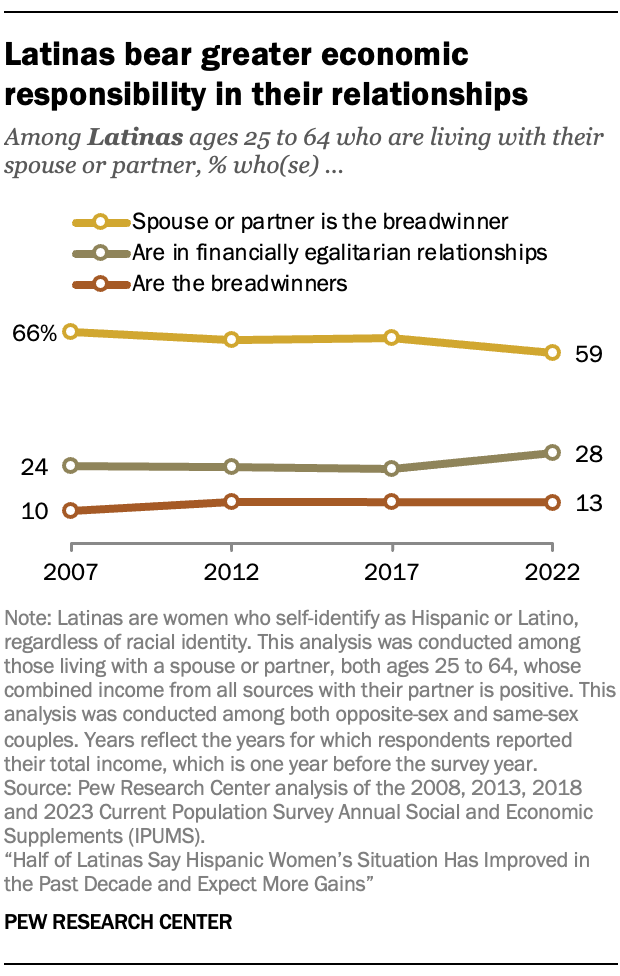Latinas have made considerable gains on several fronts in the last two decades. The share with a bachelor’s degree has roughly doubled since 2003, and their labor force participation rate and median hourly wage have both increased. However, Hispanic women still lag Hispanic men, non-Hispanic White men and non-Hispanic women in labor force participation and median hourly earnings. This chapter explores trends in Latinas’ educational attainment, labor force participation rates and earnings.

Latinas’ educational attainment
Since 2000, the number of Hispanics enrolled in postsecondary institutions has grown substantially, a trend driven more by women than men. As a result, the share of Hispanics ages 25 and older with a bachelor’s degree – both women and men – about doubled.
Despite this progress, non-Hispanic women are more likely than Hispanic women to hold a bachelor’s degree. In fact, the gap between the two groups has widened over the last two decades.
Among those ages 25 and older:
- Latinas are about twice as likely to have a bachelor’s degree today as they were in 2003 (23% vs. 12%).
- Hispanic women are more likely than Hispanic men to have a bachelor’s degree today (23% vs. 20%).
- Non-Hispanic women are nearly twice as likely as Hispanic women to have a bachelor’s degree (43% vs. 23%). The educational attainment gap between Hispanic and non-Hispanic women has widened from 16 percentage points in 2003 to 19 points in 2023.
- White men are also far more likely than Hispanic women to have a bachelor’s degree (41% vs. 23%). However, the gap has declined from 21 points in 2003 to 18 points in 2023.
Latinas’ labor force participation

The share of civilian Hispanic women ages 25 to 64 participating in the labor force – those who are employed or actively looking for work – has increased in the past 20 years. While Hispanic women still lag both non-Hispanic women and Hispanic men in their labor force participation rate, the gaps have somewhat narrowed since 2003.
- Hispanic women increased their labor force participation rate by 5 percentage points, from 64% in 2003 to 69% in 2023.
- Yet Hispanic men (87%), White men (84%) and non-Hispanic women (74%) all have higher labor force participation rates than Hispanic women today.
However, Hispanic women’s labor force participation gaps with each of these groups narrowed. From 2003 to 2023:
- The participation gap between Hispanic women and White men narrowed by 8 percentage points.
- The participation gap between Hispanic women and Hispanic men narrowed by 7 points.
- The participation gap between Hispanic women and non-Hispanic women narrowed by 4 points.
Latinas’ earnings

Hispanic women ages 25 to 64 saw their median hourly wage increase from $15.83 in 2003 to $19.23 2023, a 22% increase. This means that in 2023, half of Hispanic women earned more than $19.23 per hour and half earned less. Yet Hispanic women continue to earn less than Hispanic men, non-Hispanic women and non-Hispanic White men. The gaps between Hispanic women and these groups have changed little since 2003, if at all.
Trends in Latinas’ median hourly earnings
- In 2023, Hispanic women earned a median of $19.23 per hour compared with $15.83 per hour in 2003 (adjusted for inflation), a 22% increase.
- Yet Hispanic men ($22.50 per hour), non-Hispanic women ($25.00 per hour), and White men ($31.00 per hour) still earned more than Hispanic women at the median in 2023.
Trends in wage gaps, 2003-2023
- The gender pay gap among Hispanics has not changed significantly since 2003. Then, a Hispanic woman earned 87 cents for every dollar earned by a Hispanic man, at the median. This ratio stayed about the same at 85 cents in 2023.
- The pay gap between Hispanic and non-Hispanic women has changed only slightly. In 2003 and 2023, a Hispanic woman made just 73 and 77 cents for every dollar earned by a non-Hispanic woman at the median, respectively.
- The pay gap between Hispanic women and White men narrowed some. In 2003, a Hispanic woman earned 55 cents for every dollar earned by a non-Hispanic White man, at the median. In 2023, a Hispanic woman earned 62 cents for every dollar earned by a non-Hispanic White man.
Latinas as breadwinners in their relationships

Latinas have taken on larger shares of the economic responsibility in their relationships over time. From 2007 to 2022, Latinas ages 25 to 64 who live in the same household as their spouse or partner became more likely to be in financially egalitarian relationships (meaning they brought in 40% to 60% of the couple’s combined income) or to be the breadwinners (meaning they brought in more than 60% of the couple’s combined income).
- As a result, the share of Latinas whose spouse or partner (living in the same household) was the breadwinner decreased from 66% to 59% during that time.
- Meanwhile the share of Latinas who were breadwinners ticked up from 10% to 13%, as did the share of those in financially egalitarian relationships, from 24% to 28%.
- Numerically, the number of Latinas who earn as much as their spouse or partner, or more, increased from about 600,000 in 2007 to 1.1 million in 2022.




